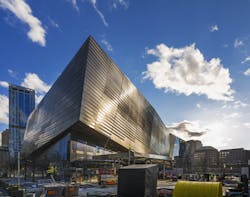NEW YORK — Your mind begins to race with thoughts of sorrow, anger, as you enter the pavilion to the 9/11 Memorial Museum in quiet reflection. One thought that shouldn’t be on your mind is comfort.
Open since May 2014, the pavilion, which serves as the entryway for the 9/11 Memorial Museum, will host millions of visitors every year. As visitors line up outside the 9/11 Memorial Museum, Jaga Climate Systems heats up much of its entryway pavilion as cooler temperatures arrive. Several of Jaga’s Mini Canal radiators were customized — with an architectural grille — for the in-floor — recessed in-trench — perimeter heating solution located inside the glass-walled pavilion. The units were designed to line the pavilion’s irregularly shaped walls, which were constructed using the I-beams from the original World Trade Center Towers.
The goal is to allow visitors to find a place that is a naturally occurring threshold between the everyday life of the city and the uniquely spiritual quality of the Memorial, explained Craig Dykers, architect at Snøhetta. The firm was commissioned to design the only building on the memorial plaza — with its low, horizontal form and its uplifting geometry the Pavilion acts as a bridge between two worlds — between the Memorial and the Museum, the above and below ground, the light and dark, between collective and individual experiences.
A project several years in the making, the pavilion for the 9/11 Memorial Museum features a sleek and angular exterior that is wrapped in glass and slender rectangular aluminum panels. With an entryway that is situated between the memorial’s twin pools, it hosts security terminals, a café, an auditorium and several escalators that lead visitors down into the main memorial, which extends several levels beneath the ground.
To design the LEED Gold-aspiring building, engineers wanted a solution that would maximize occupancy space while preventing condensation from building up on the exterior walls. Customization was critical, as the solution had to line the irregularly shaped walls, which were constructed using the original I-beams from the original Trade Center towers.
Working closely with project architects, engineers, local HVAC supplier Wales Darby, and the installing contractor, P.J. Mechanical, Jaga engineers, helped design a solution that offered supplemental heat, maximizing the comfort of visitors to the center.
“Jaga sent in a team from Belgium so they could see the ‘field conditions’ and assist in every way possible; they actually walked through the whole process with the design team,” said Pat Cesare, vice president, P.J. Mechanical Corp., a full-service mechanical contractor providing commercial services for more than 43 years.
According to Mark Kiamos, senior project director, P.J. Mechanical, the thin tube radiator system — a part of the closed-loop hydronics system — are facilitated by the mechanical room in the Memorial Museum, with Taco pumps providing the water circulation.
Trench heating system
In order to design the system, project engineers worked with Wales Darby and Jaga to design an in-floor, trench heating solution using Jaga’s Mini-Canal radiators. Rather than use a stand alone or wall-mounted system, the trench heating solution prevents condensation from building up on the glass. The system also keeps visitors warm in cold New York winters by preventing cold draughts and providing a warm barrier along the exterior wall.
Energy savings was another important feature for the system. Because it was a landmark project, engineers wanted to incorporate a sustainable heating solution that limited energy use, which projects 30% energy efficiency. Jaga’s Low-H20 technology requires only 10% of the water content of a panel radiator while providing the same output. This reduces the inertia required to heat the system and allows for quicker reaction time and lower overall operating temperatures. In fact, Jaga’s convector radiators are designed to operate on a supply water temperature starting from 110°F (with optional DBE even from 90°F).
When an influx of visitors enters the museum or the sun comes out, the temperature inside the pavilion will increase. The Jaga system reacts quickly to the environmental change, keeping the building at the desired temperature. In addition, the Jaga system helps prevent condensation from building up alongside the pavilion’s glass walls. By increasing warm airflow during cold New York winters, the convectors create a warm barrier between visitors to the center and the cold radiating from the glass.
“The architect and engineers for the project wanted something that was aesthetically pleasing, customizable and highly efficient,” said Todd Schliphack, an engineer for Wales Darby. “The mini-canal radiators are extremely powerful for their size, allowing the museum management to quickly adjust temperatures based on occupancy levels or exterior heating elements. It helps maintain a comfortable temperature in the space during any event or season.”




